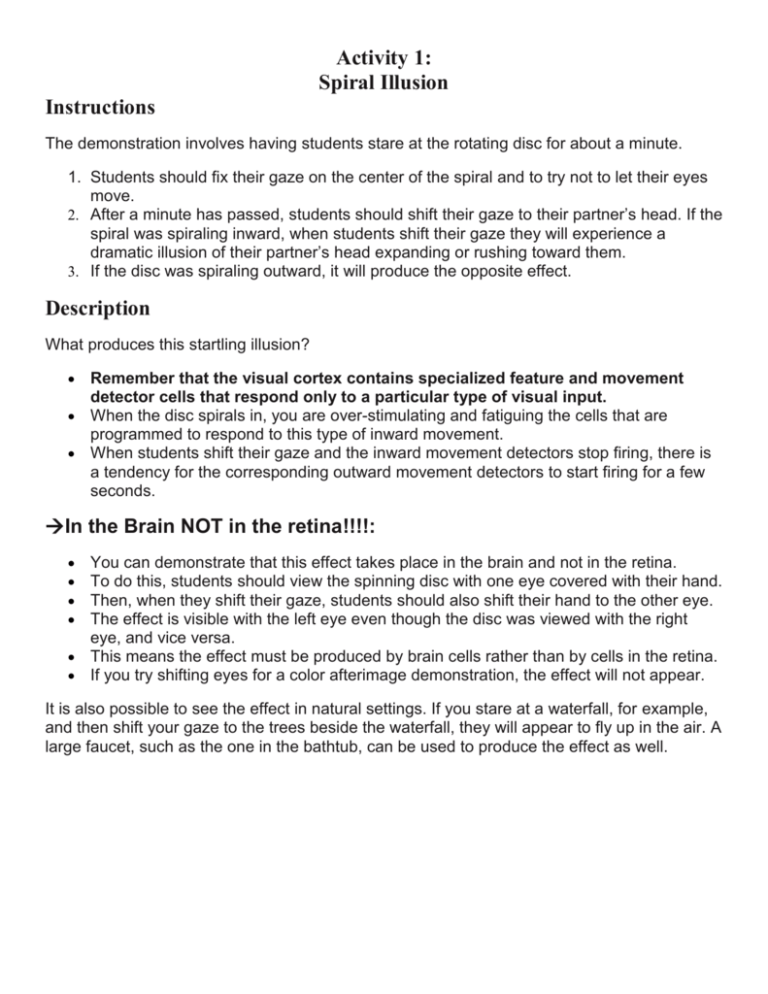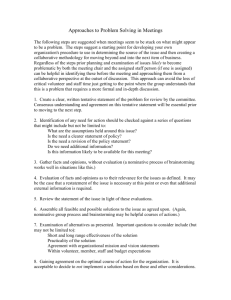brain games
advertisement

Activity 1: Spiral Illusion Instructions The demonstration involves having students stare at the rotating disc for about a minute. 1. Students should fix their gaze on the center of the spiral and to try not to let their eyes move. 2. After a minute has passed, students should shift their gaze to their partner’s head. If the spiral was spiraling inward, when students shift their gaze they will experience a dramatic illusion of their partner’s head expanding or rushing toward them. 3. If the disc was spiraling outward, it will produce the opposite effect. Description What produces this startling illusion? Remember that the visual cortex contains specialized feature and movement detector cells that respond only to a particular type of visual input. When the disc spirals in, you are over-stimulating and fatiguing the cells that are programmed to respond to this type of inward movement. When students shift their gaze and the inward movement detectors stop firing, there is a tendency for the corresponding outward movement detectors to start firing for a few seconds. In the Brain NOT in the retina!!!!: You can demonstrate that this effect takes place in the brain and not in the retina. To do this, students should view the spinning disc with one eye covered with their hand. Then, when they shift their gaze, students should also shift their hand to the other eye. The effect is visible with the left eye even though the disc was viewed with the right eye, and vice versa. This means the effect must be produced by brain cells rather than by cells in the retina. If you try shifting eyes for a color afterimage demonstration, the effect will not appear. It is also possible to see the effect in natural settings. If you stare at a waterfall, for example, and then shift your gaze to the trees beside the waterfall, they will appear to fly up in the air. A large faucet, such as the one in the bathtub, can be used to produce the effect as well. Activity 2: Activity: distribution of rods, cones, and color vision in the retina This simple activity illustrates the distribution of rods and cones in the retina and the differing ability of these photoreceptors to detect color. Concept: The demonstration shows that stimuli in the center of the visual field are detected mainly by color-sensitive cones concentrated in the fovea, whereas stimuli at the edges of the visual field are detected mainly by non-color-sensitive rods in the periphery of the retina. Materials: You will need a few pens, magic markers or other objects of various colors (e.g., red, blue, green, yellow, black), and a student volunteer with normal color vision. Instructions: 1. Ask your volunteer to sit or stand at the front of the room and to stare fixedly ahead at a 2. 3. 4. 5. 6. 7. spot or object at the back of the room. If the volunteer’s eyes stray from the fixation point, the demonstration will probably not work very well. Emphasize the need for concentrated fixation. Now stand at the volunteer’s side. Hold one of the colored objects 3 or 4 feet away from the volunteer’s ear, at about eye level. (Keep the object concealed prior to this time.) Ask the volunteer to identify the color of the object in your hand. The volunteer is not likely to be able to do this. If the volunteer answers, you can determine the level of confidence by asking how much he or she would be willing to bet on the correctness of the answer. Move a step toward the center of the room and slightly more in front of the volunteer (imagine you are moving on an arching track that would eventually place you directly in front of the volunteer) and ask the same question. Continue to move, one small step at a time, along the arc until the volunteer is certain of the object’s color. You may want to pause before each step, briefly conceal the object, and give the volunteer a chance to relax the eyes. Make sure the volunteer is staring at the fixation point again before proceeding. Discussion: You will find that most participants have excellent peripheral vision, as reflected in their ability to recognize that the object is present even when it is far off to the side. However, for most people, it will take several small steps before they can recognize the object’s color (most will first say it is black, because they are seeing it only with rods). The students will be surprised at how close to the center of the visual field the object must be before its color is clearly apparent. In real life, we perceive color in the periphery of the visual field because the brain remembers what color belongs there or makes an assumption about the likely color (e.g., the sky is usually blue). In this demonstration, however, there is no way for the brain to accurately guess the color of the object. NOTE: If the expected sequence of results does not occur, it is probably because the participant lost fixation or made a lucky guess about color. To confirm the distribution of rods and cones and their color sensitivity, you can run more trials using different colors. You can make this demonstration an active learning experience by asking students to predict the results of this procedure and to justify their predictions on the basis of material presented in class or in the textbook. Another option is to divide the class into teams of three and have them conduct the procedure, perhaps using objects of different sizes and colors, held at differing distances. Team members can take turns acting as volunteer, experimenter, and data recorder (whose job is to note the point on each trial where the object is first detected, correctly named, and its color identified). Afterward, teams can be asked to report their results to the class, including the effect of object size and distance, and to suggest plausible explanations for the discrepant data (e.g., individual differences in retinal anatomy, restricted peripheral vision, or less fixation during a trial). Activity 3: Blindspot Concept That area at the back of the eye where the nerve fibers from all parts of the retina collect to form the optic nerve is called the optic disc or, more commonly, the “blind spot.” Indeed, that portion of the retina is functionally blind—incoming light is ineffective because there are no photoreceptors in that region. The two exercises described here provide interesting illustrations of the blind spot. Materials Take a blank piece of white paper that measures 81⁄2 by 11 inches and cut it in half so it is 51⁄2 inches. Instructions 1. On one side of the paper, center and type (or print in corresponding size) a capital X and a capital Y about 4 inches apart. 2. On the other side, center and type capitals X, Y, and Z about 3 inches apart (with Y in the center). 3. For the first demonstration, hold the side of the paper with the X and Y at arm’s length while covering one eye with the other hand. If the left eye is covered, fixate on the X (assuming it is on the left), and vice versa. 4. Then slowly advance the paper toward the eye. Notice what happens to the Y: At some critical distance from the eye it disappears, but as the distance from the eye is further decreased, it reappears. You should then be able to tune the Y in and out by adjusting the distance of the paper from the eye. 5. The second demonstration involves using the side of the paper with the X, Y, and Z; holding it at arm’s length; fixating on the Y with the left eye covered; and slowly advancing the paper toward the eye. 6. At some critical distance from the eye, the Z will disappear. 7. If the paper is then held at this point, it is possible to observe an unusual phenomenon: Shifting fixation to the X causes the Y to disappear and the Z to reappear. Thus, by shifting fixation back and forth between and Y and the X, you can make the Z and the Y alternately pop in and out of view. Discussion We have a blind spot in each eye, or a total of two such spots in our typical visual field. Why don’t we see holes in that visual field? Partly because these holes are eliminated by eye movements that shift the parts of the visual field to different portions of the retina. In addition, our visual system tends to fill in gaps in what we see in a manner similar to the Gestalt principle of closure. As a result, we are unaware of our blind spots and require a demonstration such as the one described above to illustrate their existence. Activity 4: The Stroop Effect Concept In this activity, the subject sees the name of a color printed in a different color ink than its name. Because these two pieces of information conflict, the subject experiences interference. As a result of experience, the subject usually ignores the ink color and attends to the meaning of the words. When directed to ignore the word and focus on the ink color, the subject has difficulty and may name the word instead of the ink color. This particular demonstration of interference is attributed to the work of James Stroop (1935) and is referred to as the “Stroop Effect.” Materials 1. colored words 2. blank words Instructions 1. For the activity students work in pairs, with one acting as the experimenter and one as the subject. 2. First, use the blank, uncolored words. Have the student read the list down and then back up. Time them. 3. Next, using the colored words, the experimenter tells the subject not to say the words that are printed, but to say aloud the colors that the words are printed in, as fast as possible. They should do this down the list and then back up. Time them and the experimenter should record the number of errors. 4. Then the experimenter tells the subject to try the activity with the stimulus upside down. 5. Ask the teams to account for the difference in the amount of time it takes between the colored and uncolored list and the number of errors. 6. If the students attribute the difference to practice, have the subjects and experimenters switch roles and try the activity in reverse order. Discussion The words themselves have a strong influence over your ability to say the color. The interference between the different information (what the words say and the color of the words) your brain receives causes a problem. There are two theories that may explain the Stroop effect: Speed of Processing Theory: the interference occurs because words are read faster than colors are named. Selective Attention Theory: the interference occurs because naming colors requires more attention than reading words. Activity 5: Locating Sound Sources Concept Just as we perceive depth visually as a result of slight differences in the images on each of our two retinas, we perceive stereophonic sound as a result of receiving slightly different sound messages in our two cochleas. This is because our ears are about six inches apart. A sound coming from the right will have slightly more energy and be sensed slightly sooner at the right ear than at the left ear. Materials 1. clicker (hole puncher) 2. Tube Instructions 1. One is the subject, two are the experimenters, the fourth is the recorder/reporter. The subject sits in a chair with the experimenters at either side of him/her. 2. The subject is asked to CLOSE THEIR EYES and listen for each click and indicate the direction the sound is coming from. The subject closes his/her eyes. I 3. n any order, the experimenters click from either side of the subject, above the subject’s head, directly in front, directly in back, under the chair. The recorder writes the direction of the sound, the subject’s response, and the quickness of the response. 4. This can be repeated several times. Roles can be switched. 5. Next, the subject uses the cylinder as an ear extension. (The roller is held with the hand as a seal between the cylinder and ear.) 6. The same procedure is followed as without the use of the cylinder. The groups summarize and compare their observations. Discussion Because the ear closer to the sound receives a louder stimulus, receives it before the other ear, and may perceive a wave-phase difference, sounds coming from either the left or right can be quickly located by subjects. Sounds from above, below, in front, and back are more difficult to locate. Students who cock their heads are better able to locate sounds coming from above, below, in front, or back than those who keep their heads still. When the cylinder is used, the result is similar to that of using displacement goggles with vision. The effect of the cylinder is to move the ears further from one another. Clicks directly above, below, from front or back seem closer to the ear without the extension, off- center. (If you don’t have metal crickets/clickers, tapping a beaker with a pencil or snapping fingers will do. Because the crickets consistently make the same sound, they are preferable.)






